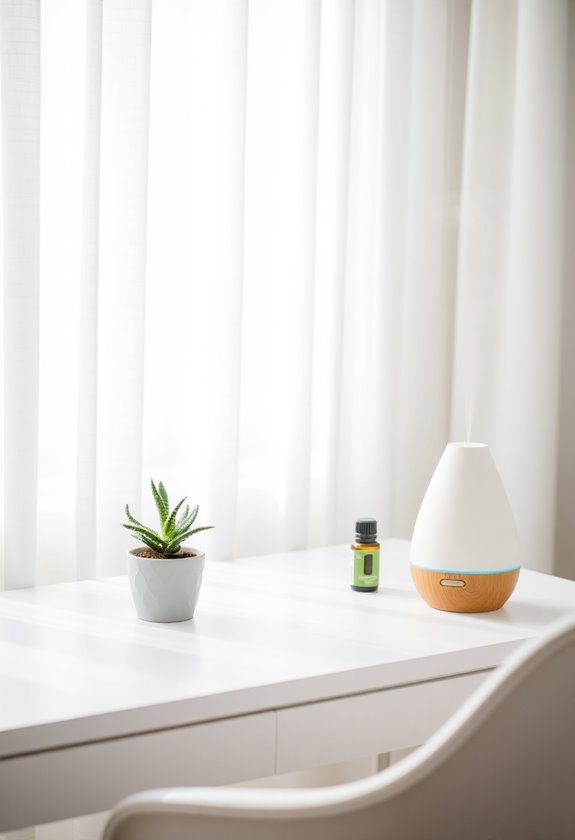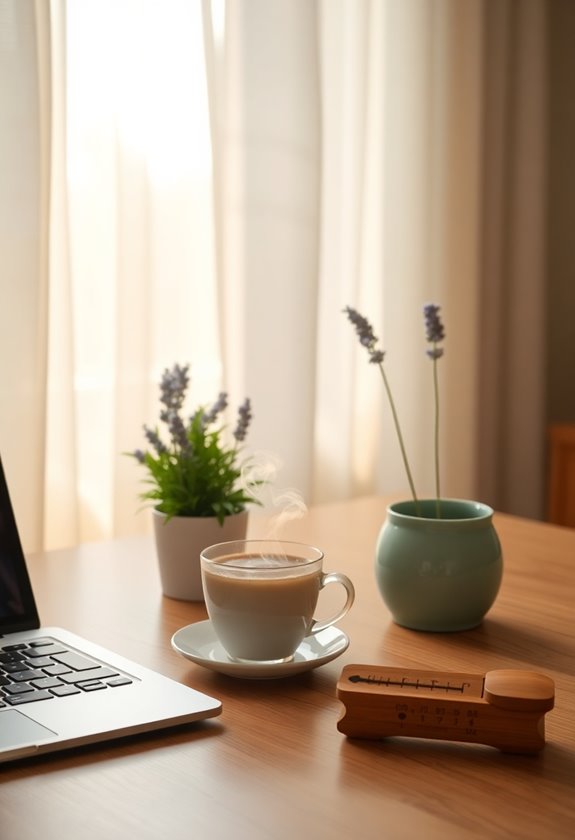You can effectively reduce workplace stress through natural methods that fit seamlessly into your office routine. Start with desk breathing exercises like the 4-7-8 technique or box breathing to reset your nervous system throughout the day. Incorporate quick stretches, including shoulder rolls and neck rotations, while taking regular mindful breaks every 90 minutes. Connect with nature by adding small plants to your workspace and positioning your desk near natural light when possible. Maintain an organized workspace and practice digital detox periods to minimize mental clutter. These foundational practices open the door to deeper stress management techniques.
Highlights
- Practice desk breathing exercises like 4-7-8 technique or box breathing to reset your nervous system and promote calmness.
- Take regular movement breaks with office stretches and walking meetings to reduce muscle tension and boost energy.
- Connect with nature by adding plants, positioning near windows, and displaying nature photographs in your workspace.
- Implement mindful breaks every 90 minutes using the 3-3-3 technique to ground yourself and reduce stress.
- Organize your workspace with daily rituals and create clutter-free zones to minimize visual stress triggers.
Desk Breathing Exercises

A worker's breath is their most powerful tool for managing stress at their desk. You'll find that controlled breathing can quickly reset your nervous system and bring you back to a centered state of mind.
- Try the 4-7-8 technique: Inhale through your nose for 4 counts, hold for 7 counts, then exhale through your mouth for 8 counts, repeating this cycle four times.
- Practice box breathing when you're feeling overwhelmed: Breathe in for 4 counts, hold for 4 counts, exhale for 4 counts, and hold again for 4 counts.
- You can also use diaphragmatic breathing by placing one hand on your chest and the other on your belly, ensuring that your belly expands more than your chest as you take slow, deep breaths for five minutes.
Quick Office Stretches

Your body's natural need for movement shouldn't be ignored during long hours at the desk. You can perform these effective stretches right at your workstation to release tension and improve circulation.
- Shoulder rolls: Roll your shoulders forward and backward 10 times while keeping your spine straight and breathing deeply.
- Neck stretches: Gently tilt your head to each shoulder, holding for 15 seconds, while keeping your opposite shoulder pressed down.
- Wrist rotations: Make circles with your wrists in both directions to prevent carpal tunnel strain and maintain joint flexibility.
- Ankle flexes: Point and flex your feet under your desk, then rotate each ankle clockwise and counterclockwise 10 times.
- Seated twists: Place your hand on the back of your chair and rotate your torso, holding for 20 seconds on each side.
Using an adjustable footrest while performing these stretches can enhance your comfort and promote better posture throughout the day.
Mindful Breaks

While physical movement helps release bodily tension, taking mindful breaks throughout the day can calm both mind and body. You'll find greater mental clarity and reduced stress levels when you incorporate these mindful practices into your workday:
- Set a timer every 90 minutes to take a 5-minute breathing break, during which you'll focus solely on slow, deep breaths while letting your thoughts drift by.
- Practice the "3-3-3 technique" where you name three things you can see, three things you can hear, and three things you can feel to ground yourself in the present moment.
- Step away from your screen and spend two minutes scanning your body from head to toe, consciously releasing tension from each muscle group you encounter.
These mindful moments help reset your stress response and improve your focus throughout the workday.
Green Space Connection

Nature's calming influence can transform your workspace into a more peaceful environment. You'll find that incorporating natural elements into your office setting can greatly reduce stress levels and improve your overall mental well-being throughout the workday, especially when you're facing demanding tasks or tight deadlines.
- Place small potted plants on your desk to create a direct connection with nature while working
- Position your workspace near windows to maximize natural light exposure during office hours
- Display nature photographs or artwork featuring landscapes on nearby walls
- Keep a small desktop water fountain nearby to provide natural white noise
- Use natural materials like wooden desk accessories or stone paperweights in your workspace
These green elements serve as visual anchors that help ground you during stressful moments, while simultaneously purifying the air and creating a more aesthetically pleasing environment. Consider adding a Himalayan salt lamp to your desk for its soothing amber glow and potential air-purifying properties.
Workspace Organization Rituals

Maintaining an organized workspace serves as a powerful stress-reduction technique that you can practice daily. Here's how you can establish effective organization rituals:
- Start each morning by clearing your desk of yesterday's items, wiping surfaces clean, and arranging essential tools within arm's reach.
- Create designated zones for different activities, such as a focused work area, a reference materials section, and a space for upcoming tasks or projects.
- Set aside 10 minutes at day's end to sort through papers, file documents electronically, and prepare your workspace for tomorrow's tasks.
- Implement a "touch it once" rule where you'll immediately handle, file, or discard items that cross your desk rather than letting them accumulate.
These systematic organization practices will help reduce visual clutter that can trigger stress responses in your brain.
Consider installing cable management trays to keep your desk free from tangled cords and wires that contribute to workspace chaos.
Walking Meditation

Regular walking meditation offers office workers a powerful way to blend physical movement with mindfulness during their workday. You'll find this practice especially effective during lunch breaks or between meetings, when you can step away from your desk to practice intentional walking while maintaining awareness of your breath and surroundings.
- Focus on each step's sensation, from heel strike to toe lift, while maintaining a natural pace
- Choose a quiet hallway or outdoor path where you can walk uninterrupted for 5-15 minutes
- Coordinate your breathing with your steps, taking three steps per inhale and three per exhale
- Keep your gaze soft and slightly downward, about six feet ahead of you
- Return your attention to your walking whenever your mind wanders, without self-judgment
This mindful movement practice helps reduce workplace stress while increasing both physical energy and mental clarity.
Aromatherapy at Work

Incorporating aromatherapy into your workspace can create a calming environment that reduces stress and enhances focus. You'll find that essential oils like lavender, peppermint, and lemon can be diffused discretely using a small USB-powered device that won't disturb your colleagues.
Consider these proven stress-reducing options:
- Place 2-3 drops of rosemary oil on a tissue near your keyboard to improve mental clarity
- Keep a rollerball blend of lavender and bergamot in your desk for quick application to pulse points
- Use a eucalyptus-infused desk spray to refresh your area and clear your mind
When selecting scents, you'll want to choose lighter fragrances that won't overwhelm shared spaces, while ensuring you've checked your company's policies regarding fragrance use in the workplace.
Digital Detox Moments

Brief breaks from digital devices can considerably reduce workplace stress and eye strain. You'll find that incorporating regular digital detox moments throughout your workday helps maintain better focus and reduces mental fatigue, while giving your eyes much-needed rest from constant screen exposure. When you're feeling overwhelmed by endless notifications and digital demands, step away from your devices to reset your mental clarity.
- Set your phone to "Do Not Disturb" mode for 15-minute intervals every two hours
- Take handwritten notes during meetings instead of typing on your laptop
- Stand up and look out a window, focusing on distant objects for 20 seconds
- Practice offline brainstorming using traditional pen and paper
- Schedule short walking meetings without any digital devices present
Frequently Asked Questions
How Does Caffeine Consumption Affect Workplace Stress Levels?
While moderate caffeine intake can boost your alertness and productivity, excessive consumption can considerably increase workplace stress levels. You'll find that too much caffeine triggers anxiety symptoms, raises your blood pressure, and intensifies stress responses to workplace challenges. It's best to limit yourself to 400mg of caffeine daily, spacing out your intake to avoid the jittery, anxious feelings that can amplify work-related stress.
What Role Does Office Lighting Play in Employee Stress Management?
Office lighting directly impacts your stress levels through its influence on your circadian rhythm and overall wellbeing. Poor lighting can strain your eyes and trigger headaches, while proper illumination helps maintain your natural energy patterns throughout the workday. You'll benefit most from a combination of natural daylight and adjustable artificial lighting that you can modify based on your tasks and the time of day.
Can Background Music Help Reduce Work-Related Stress?
Music can be your ticket to tranquility during a hectic workday. You'll find that background music helps reduce cortisol levels and muscle tension, especially when you choose instrumental tracks at a moderate volume. Studies show that listening to familiar, pleasant music while working can lower your heart rate and improve focus, though you'll want to avoid songs with lyrics when performing tasks that require intense concentration.
How Do Workplace Relationships Impact Individual Stress Levels?
Your workplace relationships greatly influence your daily stress levels through multiple channels of interaction and emotional exchange. When you maintain positive connections with colleagues, you'll experience reduced anxiety and better workplace support. Conversely, difficult relationships with coworkers or supervisors can trigger heightened stress responses, affecting both your mental well-being and job performance through increased cortisol levels and decreased job satisfaction.
Does Commute Time Significantly Affect Office Worker Stress Levels?
Your commute time considerably impacts your daily stress levels, with longer commutes directly correlating to increased anxiety and reduced job satisfaction. Studies show that you'll experience higher cortisol levels and blood pressure when facing commutes exceeding 45 minutes each way. When you spend more than an hour traveling to work, you're 33% more likely to suffer from depression and decreased work performance compared to those with shorter commutes.




